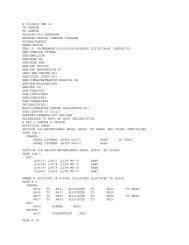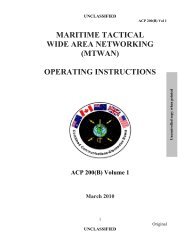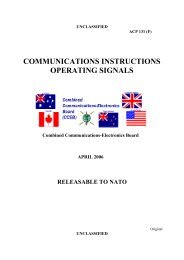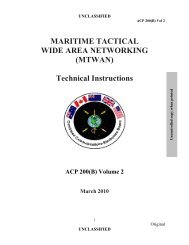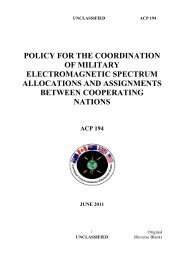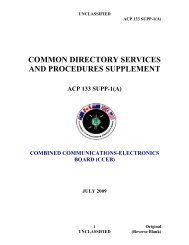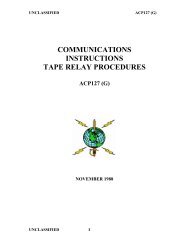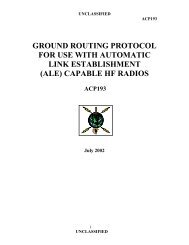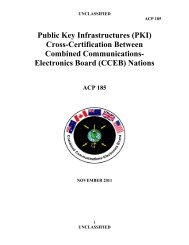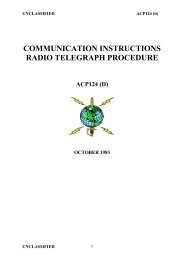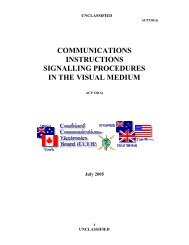ACP 201
ACP 201
ACP 201
Create successful ePaper yourself
Turn your PDF publications into a flip-book with our unique Google optimized e-Paper software.
Uncontrolled Copy When Printed<br />
UNCLASSIFIED<br />
<strong>ACP</strong> <strong>201</strong><br />
a. Tactical systems are usually self-contained within a command structure and are<br />
designed to allow the commander to conduct his mission at the operational level.<br />
b. Strategic systems are generally more global in nature and are operated on either a<br />
common-user or special purpose basis. While a strategic system may be confined<br />
within a specified area, it may also be limited to a particular type of traffic.<br />
106. Whilst <strong>ACP</strong> 121 clearly defines strategic and tactical level communication, modern<br />
TCP/IP based communications systems are best situated at the Operational level providing<br />
communications services to the Strategic, Operational and Tactical levels. Consequently<br />
procedures and doctrine have to be developed in order to support this new paradigm Future<br />
emphasis will be toward direct services between users of computer terminals, in the form of<br />
desktop-to-desktop facilities using tools such as chat, e-mail and web services. Furthermore,<br />
developments in LOS ad-hoc networking will reduce the reliance on satellite services and enable<br />
voice, data, graphics, and video or imagery to be fully exploited at each of the strategic,<br />
operational and tactical levels.<br />
PURPOSE<br />
107. To meet and sustain warfighters‘ messaging requirement, an operational construct that<br />
effectively and efficiently employs all available information tools must be sourced. The intent of<br />
this document is to provide a ―concept‖ that will meet this requirement. This concept is based on<br />
the establishment of an operational doctrine, with integrated lines of authority, processes and tools,<br />
that is responsive to all MNTG domains. The objective is an end-to-end tactical command and<br />
control capability with integrated doctrine, tactics, techniques and procedures (TTP) that manages<br />
and directs tactical messaging at the Task Group level.<br />
108. Collaborative tools, applications and operating systems run on information systems. It is<br />
therefore imperative that the efforts of those responsible for managing the information are<br />
intimately linked to those responsible for managing the systems and networks, in order to develop<br />
the most appropriate collaborative solutions to meet the Commander‘s needs.<br />
SCOPE<br />
109. Chapter 1 of this publication is designed to provide the basic Concept of Operations for<br />
information exchange using IP systems within the context of an AUSCANNZUKUS MNTG,<br />
under the tactical command and control (C2) of a designated authority. Chapters 2, 3 and 4<br />
provide more in-depth explanation of the means and use of tactical messaging tools, supported by<br />
accompanying annexes that provide the Standard Operating Procedures (SOPs) associated with the<br />
use of email, chat and web services.<br />
110. Such a MNTG invariably operates in a bandwidth constrained environment across a<br />
Coalition/Allied MTWAN. Whilst most MNTG operations will be conducted on an appropriately<br />
covered and secured MTWAN, from time to time it may be necessary for MNTG units to operate<br />
in support of specific activities involving external Government and Non-Government agencies.<br />
1-2 Original<br />
UNCLASSIFIED<br />
(Reverse Blank)



